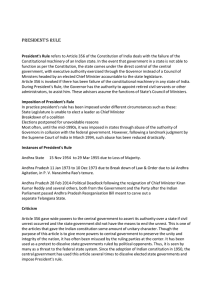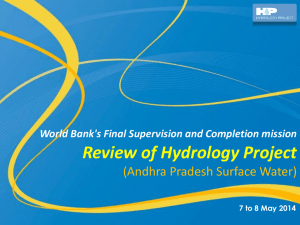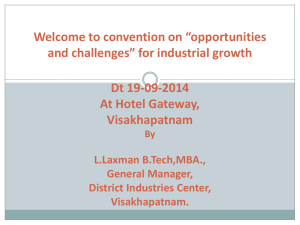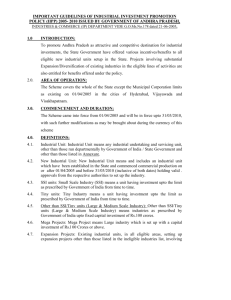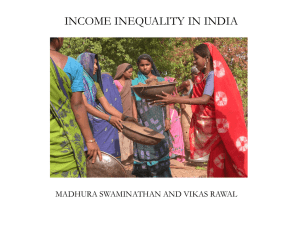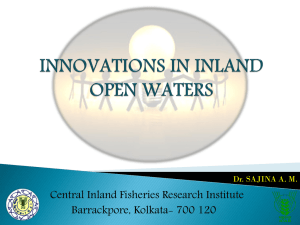AP Industrial Policy
advertisement
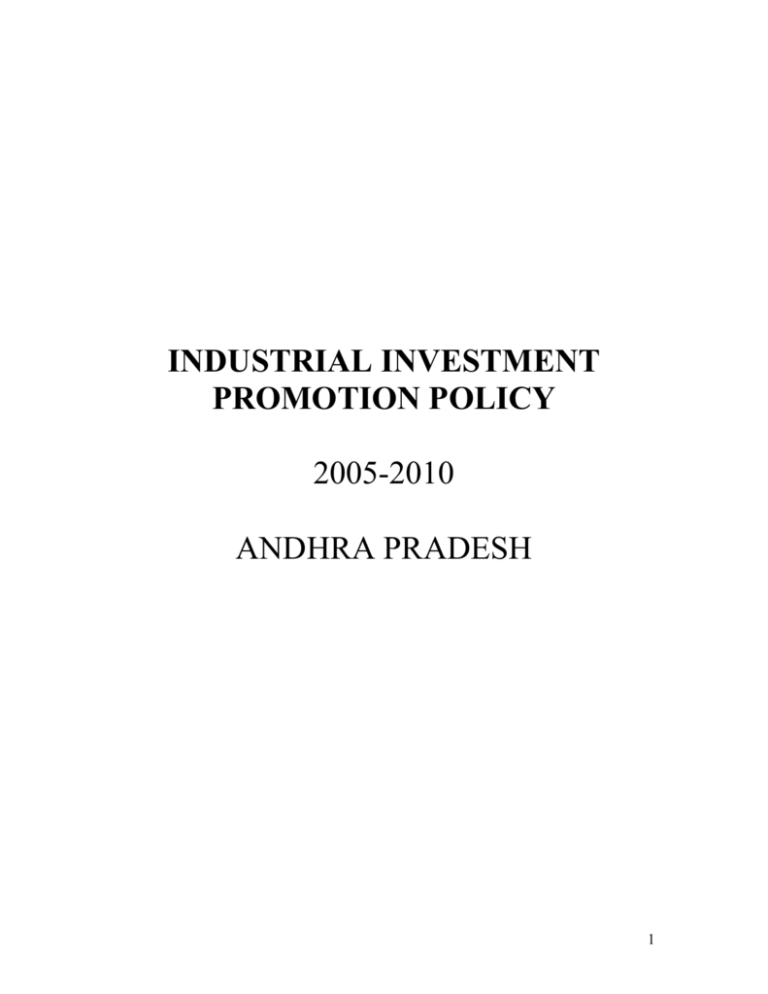
INDUSTRIAL INVESTMENT PROMOTION POLICY 2005-2010 ANDHRA PRADESH 1 INDEX Page 1. Introduction 2. Andhra Pradesh – An Attractive Investment Destination .. 2-4 3. Road Map .. 5 4. Objectives .. 6 5. Strategy .. 7 5.1 Creation of Infrastructure .. 8-11 5.2 Incentivising Investments .. 11-12 5.3 Building Industrial Competence in Women .. 12-13 5.4 Quality Competitiveness .. 13-15 5.5 Export Promotion .. 15 5.6 Environment Friendly Climate .. 15-17 5.7 Attracting Mega Investments .. 17-18 5.8 Attracting Foreign Direct Investments .. 18 5.9 Access to Market .. 18-19 5.10 Intellectual Property Rights .. 19 5.11 Fostering Industrial Clusters .. 19-20 5.12 Prevention of Industrial Sickness .. 20-21 5.13 Preventing Migration .. 21 5.14 Permitting Industries to Exit .. 21 5.15 Towards Better Regulation .. 21-23 5.16 Policy Measures – Thrust Sectors .. 23-24 .. 25-29 6.0 Abstract Statement of Fiscal Benefits .. 1 2 1.0. INTRODUCTION 1.1. Government accords highest priority to the industrial sector on account of the vital role it plays in balanced and sustainable economic growth. It plays a crucial role in the process of economic development by value addition, employment generation, equitable distribution of national income, regional dispersal of industries, and mobilization of capital, entrepreneur skills and contribution to exports. 1.2. To drive industrial growth by attracting private investments, an industrial policy statement of the State which sets out clear and credible specific measures to improve the investment climate towards better regulation by removing barriers to competition. 1.3. The investment climate is central to growth and improves outcomes for society as a whole. It reflects the many location specific factors that shape the opportunities and incentives for firms to invest productively, create jobs, and expand. 1.4. Against this back drop, Government have introduced Industrial Policy to drive industrial growth by clearly spelling out various components of incentives being offered, supply of quality power, improved infrastructure facilities etc. To remove the existing barriers; and for creation of congenial and hassle-free investment climate and also to boost investor confidence, a series of proactive measures are being proposed. 3 2.0. ANDHRA PRADESH – AN ATTRACTIVE INVESTMENT DESTINATION 2.1. Andhra Pradesh is the fifth largest State in the country with an area of 2, 76,754 sq. km, accounting for 8.4 % of India’s territory with 76.7 million population. Andhra Pradesh is strategically located in the Indian subcontinent and the State has the longest coastline (972 km) among all the States in India. Its capital Hyderabad occupies a central location and is well connected with the rest of the world through its seaports on the eastern coast and its international airport. Well-established air, road, and railway networks link it to the rest of India. 2.2. Andhra Pradesh has bountiful natural resources. Endowed with fertile land, water, and conducive agro-climatic conditions and it is an agriculturallyprosperous state. Nearly 75% of its area is covered by the river basins of the Godavari, Krishna and Pennar, and their tributaries. There are 17 smaller rivers like the Sarada, Nagavali and Musi, as well as several streams. Godavari and Krishna are the two major perennial rivers, and with their extensive canal system, provide assured irrigation. 2.3. Andhra Pradesh is the only State with abundant energy. It has an installed capacity for generating 10 273.44 MW, the second highest in the country and many projects are under implementation to generate 4715 MW by 2009. Among all Indian States, Andhra Pradesh has progressed furthest in reforming its energy sector (privatisation, separation of generation from transmission and distribution). 2.4. Vast natural gas reserves found in Krishna–Godavari basin with 47 million standard cubic metres per day have opened up immense possibilities for environment-friendly industrial and socio-economic development in Andhra Pradesh. In terms of industrial development, Andhra Pradesh has progressed rapidly. Its gross state domestic product (in PPP) was $150 billion during 2002-03. It has thus emerged as one of the most attractive investment destinations, ranking third in India High Potential Sectors 2.5. Andhra Pradesh’s strength lies in its fully diversified industrial base, with the thrust on high-tech sectors including information technology, pharmaceuticals, biotechnology and Nano Technology. Traditional sectors such as textiles, leather, minerals, and food processing are also being further developed for high value addition. 4 Competitive Investment Climate 2.6. The state has an exclusive financial institution APSFC for providing finance to small industry. Apart from this 5288 commercial banks are functioning in the state in rural and urban areas. The state has a good network of specialized SSI branches for extending assistance to small and tiny industry. 2.7. In the Industrial infrastructure front, the State has taken lot of initiatives for development of industrial infrastructure for the consistent growth. Government in association with APIIC has initiated a set of prestigious projects that include industrial infrastructure, social infrastructure and infrastructure for the specific sectors. The state owned corporation APIIC has already set up 272 industrial estates and specialized parks like ICICI Knowledge Park, SP Bio-tech Park, Marine Bio-tech Park, Agri Bio-tech Park, Special Economic Zone, Pharma City, Hardware Park, HITEC city, Leather Parks, Food Processing Park, Agri Export Zones etc. 2.8. The state has one major port at Visakhapatnam which handles largest tonnage among all Indian ports and minor ports at Kakinada, Krishnapatnam, Vadarevu and Gangavaram. 2.9. The State has undertaken wide-ranging measures to nurture its industries: simplified, less restrictive regulations, labour and fiscal reforms, incentives. In line with this objective, the State has enacted a law for single-window clearances. It is the first Sate in the country to have a law for single-window clearances, which ensures that all clearances to investors are given within a set period. The State has been qualified as "flexible" in its approach to labour regulations and "good" for its simplification of rules and regulations. It introduced the self-certification concept, common annual returns in place of multiple returns with simplified registers, and zero inspection regime through accredited agencies. 2.10. As part of its continuing search for ways to ensure a better quality of life, the State has been in the forefront in building its intellectual capital. Andhra Pradesh offers a high quality of life for expatriates and other members. Hyderabad the capital city of A.P has wide ranging facilities for leisure and cultural activities, and entertainment. It has a long culture of social clubs, some of which are over a hundred years old. Swimming Clubs, Golf course and race courses, Food Courts, Shopping malls and floating restaurants provides much needed recreation to the local and foreign people. 5 2.11. Andhra Pradesh Tourism has much more to offer with an everexpanding infrastructure and array of facilities to take in the beauty of nature and creativity of a vibrant civilization. Cities across the State compete with the best in the country and rich past contributes to the resplendence of its people and culture. 2.12. Communal harmony, peaceful industrial relations, lower crime rate and low cost social infrastructure with safety and security make the State a right destination for any business venture. 2.13. The State provides better and advanced health care facilities with presence of Super Specialty Hospitals. Hyderabad, the capital of Andhra Pradesh has been recognized as the Health Capital of the country. 2.14. The Government has helped to establish, in collaboration with some of the well-known institutions in the world, a number of centres of excellence for training and research: the Indian School of Business, the Indian Institute of Information Technology, the National Academy for Construction and the Knowledge Park are part of this knowledge revolution. Every year, 350 000 skilled graduates pass out from universities, and 81000 engineering graduates from engineering schools, another 10 078 management students graduate from management institutions every year. About 23% of India’s software professionals within and outside the country are from Andhra Pradesh. 2.15. To provide suitable atmosphere for setting up asset management, venture capital companies, insurance companies, commercial banks, Financial District is being set-up in Hyderabad. With the establishment of Insurance Regulatory and Development Authority head quarters in Hyderabad, the State has been recognized as Insurance Capital. 2.16. It is the endeavour of the Government of Andhra Pradesh to create a conducive environment for industrial growth by providing necessary support and services. 6 3.0.ROAD MAP To make Andhra Pradesh a strong base for manufacturing sector To increase industrial investment by 10% every year with an objective to reach Rs.170 billions by 2010 by promoting rapid growth of market driven, knowledge based, efficient and competitive industrial environment. Contribution to the State GDP (GSDP) from industrial sector to be increased from 12.9 % to 15 %. Creation of additional employment opportunities To improve exports from the State by increasing the present share of exports in India from 4.39% to 10% by 2010 Rural Industrialization with emphasis for promoting cottage and micro enterprises 7 4.0.OBJECTIVES Promote Andhra Pradesh as an attractive destination for industrial investments To market Andhra Pradesh as competitive investment destination for Foreign Investments To create enabling environment for ensuring maximum value addition to the abundant locally available resources To enhance quality of life in the State to suit to the needs of the investors To attract and develop appropriate entrepreneurial leadership, management and HRD systems Alleviate regional disparities in economic growth Improving infrastructure by facilitating investment in industrial infrastructure in private sector. To encourage establishment of New Tiny and Small Scale Industries particularly in rural areas to achieve the twin objectives of employment generation and utilization of local resources To encourage, attract and involve women entrepreneurs in industrial capacity building To withstand global competition, Special Emphasis on qualitative competitiveness through Technology upgradation and protecting Intellectual Property Rights To arrest environmental degradation Encourage cluster concept to make the industries in the Clusters Globally Competitive To develop effective regulatory mechanism for entry and operation of firms Create a market driven environment with the private sector being the primary engine for growth. Special Emphasis for restructuring and consolidation of sick industrial units 8 5.0.STRATEGY 1. CREATION OF QUALITY INFRASTRUCTURE 2. INCENTIVISING INVESTMENTS 3. BUILDING INDUSTRIAL COMPETENCY IN WOMEN 4. QUALITY COMPETITIVENESS 5. EXPORT PROMOTION 6. ENVIRONMENTAL FRIENDLY CLIMATE 7. ATTRACTING MEGA INVESTMENTS 8. ATTRACTING FOREIGN DIRECT INVESTMENT 9. ACCESS TO MARKET 10. INTELLECTUAL PROPERTY RIGHTS 11. FOSTERING INDUSTRIAL CLUSTERS 12. PREVENTION OF INDUSTRIAL SICKNESS 13. PREVENTING MIGRATION 14. PERMITTING INDUSTRIES TO EXIT. 15. TOWARDS BETTER REGULATION 16. POLICY MEASURES- THRUST SECTORS 9 Applicability of the Policy 5.0 In order to achieve the objectives envisaged, Government offers the following incentives/benefits to all eligible industrial units set up in the State except in the Municipal corporation limits of Visakhapatnam, Vijayawada and Hyderabad and commence commercial production on or after 1.04.2005 but before 31.03.2010. Projects involving substantial Expansion/Diversification of existing industries in the eligible lines of activities are also entitled for benefits offered under the policy. The list of ineligible lines of activities/industries would be notified separately along with operational guidelines of the policy. 5.1. Creation of quality Infrastructure 5.1.1 Development of quality infrastructure for industrial growth has been given highest priority through private participation. In line with this objective, Government has constituted Infrastructure Authority (IA) for the rapid development of physical and social infrastructure in the State and to attract private sector participation in the Designing, Financing, and construction of, operation and maintenance of infrastructural projects. Land 5.1.2 5.1.3 5.1.4 5.1.5 100% reimbursement of Stamp duty and Transfer duty paid by the industry. 100% reimbursement of Stamp duty paid by the industry on the deeds executed for lease of land/shed and buildings in favour of new industrial units. 100% reimbursement of the Stamp duty and Transfer duty paid by the industry on execution of deeds by the industrial units for securing loans, advances, mortgages and hypothecation from financial institutions/ Nationalized Commercial banks Reimbursement of 25% of the land cost purchased for industrial purpose limited to Rs.5 Lakhs in case of Industrial Estates/Industrial Development Areas of APIIC. The units availing this benefit should implement the project within a period of 24 months from the date of purchase of the land. The extent of the land will be limited as per the statutory norms. 10 5.1.6 5.1.7 Land conversion from Agriculture use to industrial use will continue to be automatic on payment required fee as per the rules in vogue. All industrial units continue to be exempted from payment of NALA tax. Water 5.1.8 5.1.9 Power Government will ensure stable prices of Municipal water for 3 years for industrial use. Reservation of 10% of water for industrial use from the existing projects as well as future projects will continue. 5.1.10 Uninterrupted quality power supply plays a crucial role in the production process and any voltage fluctuations disrupt the whole process resulting in loss of money and time. To ensure uninterrupted power supply, dedicated feeders will be provided for units located in industrial estates and industrial areas through IIDF. 5.1.11 Power cost will be reimbursed @ Rs.0.75 per unit during the first year of the policy and thereafter for the remaining four years the rate of reimbursement would be so regulated on yearly basis keeping in view the changes in the tariff structures to ensure that power cost to the industry is pegged down to the first year’s level. 5.1.12 Feeders having more than 50% of the industrial loads will be converted as dedicated industrial feeders and they will be exempted from power cuts Critical Infrastructure 5.1.13 Government besides creating quality infrastructure, emphasis is being given for creation and maintenance of critical infrastructure required in the industrial estates. Ongoing schemes like Industrial Infrastructure Development Fund (IIDF) and Critical Infrastructure Balancing Fund (CIBF) will be continued 11 5.1.14 5.1.15 5.1.16 5.1.17 5.1.18 The service Societies will be permitted to contribute 30% from the revenue earnings towards their share to get the assistance under Critical Infrastructure Balancing Fund (CIBF), if the revenue collection of the service society is more than 50% of the demand continuously for a period of 2 years. Industrial Infrastructure Development Fund of Rs 175 crores created to provide infrastructure at the door step of the industry. Infrastructure like roads, power and water will be provided at door step of the industry for stand alone units by contributing 50% of the cost of infrastructure from IIDF with a ceiling of Rs.1 cr subject to (a) the location should be beyond 10 kms from the existing Industrial Estates/IDA’s having vacant land/sheds for allotment and (b) cost of the infrastructure limited to 15% of the eligible fixed capital investment made in the industry. Interest Subsidy will be provided to APTRANSCO/ DISCOMs/Local Bodies/Water Boards on the loans raised by them for creation of infrastructure like power and water at the door step to the industries located in Industrial Estates and Clusters. Equated Monthly Installments (EMI) on the loans raised by these organisations will be paid by the Government till such time industrial units are established and revenue inflows start to these agencies /utilities. In order to ensure optimum utilization of the new gas find of 47 MSCMD at Krishna Godavari basin, pipeline and other infrastructure will be developed to encourage gas based power generation as well as individual industries. Development of Industrial Corridors 5.1.19 To capitalize the natural resources and other advantages available in the sub-regions, Government is proposed to develop industrial corridors in various parts of the State for sustainable and equitable industrial development. 12 Special Economic Zone 5.1.21 Government of India is coming out with a Special Economic zone Act for streamlining the development of Special Economic Zones in the Country. The State Government will take full advantage of the Act for promoting Special Economic Zones in various parts of the State for balanced trade and commerce with liberal tax, fiscal and administrative regime. Government of Andhra Pradesh is promoting an SEZ at Visakhapatnam over an area of 1400 hectares in the first phase and another one is under contemplation in Kakinada. 5.2.0. Incentivising Investments a. Investment subsidy 5.2.1. To provide support to the investors at entry level and to give fillip to industrial growth, Government is considering the Small/Tiny industrial units for providing cash subsidy. 5.2.2. 15% investment subsidy on fixed capital investment will be given to SSI/Tiny industrial units subject to a maximum of Rs.15 lakhs 5.2.3. An additional subsidy of 5% on fixed capital investment subject to a maximum of Rs.5 lakhs will be provided to SC/ST entrepreneurs. b.Growth enabling incentives: 5.2.4 25% of the tax paid during one financial year will be ploughed back to Tiny/SSI/Large & Medium Industries as a grant by the Government towards the payment of tax during next year. Benefit will be available for 5 years from the date of commencement of production i.e upto 6th year. This will act as impetus for sustained growth of industrial production. 13 c. Credit Support 5.2.5 Finance has been identified as the most important factor determining the survival and growth of small and medium enterprises. Access to finance allows industrial units to undertake productive investments to expand their businesses and to acquire the latest technologies, thus ensuring their competitiveness and that of the nation as a whole. 5.2.6 Lowering interest rates is often proposed as the best way to spur investment and the Government of AP will provide subsidy for Small and Tiny industrial units. 5.2.7 A 3% interest rebate on Prime Lending Rate (PLR) will be given on the term loan taken by new Tiny/SSI industrial units subject to a maximum of Rs.5.00 lakh per year for a period of 5 years. 5.2.8 5% of the project cost will be provided as seed capital assistance to SSI/Tiny industries started by SC /ST entrepreneurs as a grant for the industries which were sanctioned seed capital assistance by Prime Lending Institutions under National Equity Fund Scheme subject to a maximum of Rs.5 lakhs 5.2.9 Under Credit Guarantee Fund (Scheme) operated by SIDBI, credit will be provided without any collateral security for industrial units upto a limit of Rs.25 lakhs of investment. To support this initiative and also to improve credit flow to small scale sector, a corpus fund will be provided matching the contribution made by the consortium of industries in IE’s/Clusters subject to a maximum limit of Rs.25 Lakhs. c. Scarce Raw Materials 5.2.10 Industries Department has taken initiative to simplify the procedures for allotment of scarce raw materials like coal, alcohol etc for timely and easy allotment of these materials on the recommendation of the Industries Department. 5.3.0 Building Industrial Competence in Women 5.3.1. According to the National Foundation for Women Business Owners (NFWBO), women Entrepreneurs represent one-quarter to one-third of the total business population in the world. Nevertheless, several studies have shown that women in developing and developed countries have serious difficulties to access finance especially for start-ups, but also for the expansion of established enterprises. Studies have shown that women 14 entrepreneurs who deal with financial institutions are often confronted with problems of gender bias. Besides, loan requests will require additional and unnecessary documentation, additional guarantees or co-signers or other conditions different from male applications. 5.3.2. 5.3.3. 5.3.4. 5.3.5. 5.3.6. 5.3.7. 5.3.8. As per figures available from 3rd All India Census of Small Scale Industries, women entrepreneurs in Andhra Pradesh account for 5.4 % of the total number of units and 0.05% of the total investment. To create a level playing field for the women entrepreneurs to establish new industrial units, Government gives special treatment by providing special incentives. This facility provided to the units started by the women as sole proprietrix or having 51% share in partnership private limited companies. An additional investment subsidy of 5% on fixed capital investment subject to a maximum of Rs.5 lakhs will be provided to women entrepreneurs over and above the general investment subsidy. Women belonging to SC/ST community will be given another 5% investment subsidy on fixed capital investment subject to a maximum of Rs.5 lakhs 5% of the project cost will be provided as seed capital assistance to SSI/Tiny industries started by women entrepreneurs as a grant for the industries which were sanctioned seed capital assistance by Prime Lending Institutions under National Equity Fund Scheme subject to a maximum of Rs.5 Lakhs. Women entrepreneurs will be provided with 5% interest rebate on Prime Lending Rate (PLR) subject to a maximum of Rs.5.00 lakh per year for a period of 5 years. 5.4.0 Quality Competitiveness Technology upgradation 5.4.1. Technology is the key element, contributing to productivity, quality, competitiveness and market acceptability of products. In rapidly changing global scenario, technology and business incubators have emerged as useful instruments for innovation. 5.4.2. To provide technology support to the local industries, Government of Andhra Pradesh, Confederation of Indian 15 5.4.3. 5.4.4. 5.4.5. 5.4.6. 5.4.7. Industry and TIFAC jointly promoted Andhra Pradesh Technology Development and Promotion Centre (APTDC) for transfer of technologies, providing technological know how, commercialization of technologies, technology upgradation etc. In line with this objective, APTDC is in the process of developing “T” Incubator – a technology incubation programme is an innovative system designed to assist entrepreneurs in the development of new technology based firms, both start-ups and fledglings linking talent, technology, capital and know how to leverage entrepreneurial talents in the State. This apart, the Indian School of Business “K-hub” was developed to create linkages among the technology providers, academicians, incubators, business development service, leverage existing infrastructure and centers to promote development of high quality of entrepreneurship and to pool and share international best practices in incubation/mentoring processes. To make the industries technically competitive and also to adopt latest technologies, SIDBI is operating Credit Linked Capital Subsidy Scheme. To further accelerate the process of technology upgradation, the State Government offers An additional subsidy of 8% over and above 12% subsidy provided by SIDBI under Credit Linked Capital Subsidy Scheme(CLCSS) for new industrial units Industries will be facilitated in getting assistance from the funding agencies like NEDCAP, IREDA etc in implementing the Energy conservation and non-conventional energy equipment in their manufacturing Process b. Quality Promotion 5.4.8. Quality is the standard acceptable by the customer. Qualitative competitiveness plays crucial role in marketing the products due to the image its products have or due to higher quality and / technological or market specifics. To encourage quality manufacturing, industrial units will be considered for incentives to obtain quality certification. 5.4.9. Reimbursement of 50% of the expenditure incurred by the industrial units in getting the BIS, ISO 9000 / 14000 or any 16 5.4.10. 5.4.11. other national or international certification subject to a maximum of Rs.1.00 lakhs Motivation campaigns for quality upgradation in association with BIS, Ministry of Food Processing and other reputed agencies will be organized and a special cell will be created for providing necessary guidance. Best entrepreneurs from SSI/Tiny units will be honoured with awards in recognition to their best performance 5.5.0. Export Promotion 5.5.1. 5.5.2. 5.5.3. 5.5.4. 5.5.5. 5.5.6. 5.5.7. Export plays major role in the industrial and economic development. In view of the trends in the world market, exports gained much significance and long term export opportunities emerged besides opening up of avenues for exports. To capture this opportunity, the State needs to actively develop export markets. In order to boost exports from Andhra Pradesh Government is offering a special package of incentives to Export oriented units Sales tax exemption on Purchase of raw materials for export oriented units For export oriented units, APSFC will extend financial assistance at a concessional rate of interest Export Industries will be given a 30% grant for ground rent for participation in the international trade fairs subject to a maximum limit of 9 sq mts To Sensitize Exporters, programmes will be conducted with the assistance of EAN India and SISI about the bar-coding. Export Awards will be provided to EOUs to recognise best performing units in regard to quality, R &D and Performance. Government will set up a State-of-Art external information centre in collaboration with local chamber of commerce and associations like CII, FAPCCI, FAPSIA, FIEO etc. and with the assistance of reputed National/International organizations for dissemination of information and assistance to export fraternity of the State. 5.6.0. Environment Friendly Climate 5.6.1 Adopting a pollution prevention progrmamme as a way of doing business can yield a number of significant benefits for a company. The major benefit is improved quality of the environment and the result of reduced generation and discharge of hazardous 17 5.6.2 5.6.3 5.6.4 5.6.5 5.6.6 5.6.7 5.6.8 5.6.9 5.6.10 pollutants. Pollution prevention programmes in addition offer other benefits in four basic categories: Economic, potential future liability, competitive advantage, and positive public image. The role of Government agencies in promoting pollution prevention is to provide incentives that help overcome technical and financial barriers to waste reduction. To provide more and more effective assistance for environmentally sustainable industrial growth, Government supports the industry in implementing the regulatory enforcement and technical and economical assistance mechanisms Entrepreneurs would be assisted to set up new units according to the environmental zoning maps prepared by the A.P. Pollution Control Board. Waste Minimization circles will be promoted by the Pollution Control Board in centralized locations where there is a concentration of industries for providing necessary inputs in reducing the wastages in their plants. Pollution Control Board will create awareness about these measures to the industrial community All objections for the establishment of industrial projects will be informed by the A.P.Pollution Control Board before a project is sanctioned to avoid abandonment of projects after substantial investment made by the investors . APPCB will conduct awareness programmes to disseminate information regarding the environmental issues as lack of information can cause needless panics./regret To encourage environment friendly technologies, 25% subsidy will be provided on specific cleaner production measures adopted in new industries subject to a maximum of Rs.5 Lakhs. Changes in the climate are occurring naturally and also due to human activities. Due to industrial revolution the environment and climate altering through changing agricultural and industrial practices resulting in increase of green house gas emissions. As per the International Energy Agency, emissions of carbon dioxide to the global atmosphere by 2010 is about 29575 million tons. The Kyoto Protocol was negotiated in 1997 for stabilization of greenhouse gases in the atmosphere at levels that would prevent dangerous changes to the global climate. Under the Kyoto Protocol, industrialized countries and those in transition to a market economy have agreed to limit or reduce their emissions of these green house gases. Under the protocol international emission 18 5.6.11 5.6.12 5.6.13 trading of carbon credit is allowed between the countries who have surplus and who have difficulty in complying with their restriction commitments. The State Government will take initiative to see that eco-friendly industries are facilitated to sell their carbon credits in consuming markets like European Union, Canada and Japan etc. The Nodal Agency for this activity will be the Environment & Forest Departments and the APPCB will support awareness windows, workshops and promotion measures to facilitate new industries avail this opportunity. Government will facilitate for setting up of Effluent Treatment plants and Hazardous waste treatment plants in various industrial estates and cluster with private sector participation. Government will facilitate studies on carrying capacities in various industrial agglomeration areas to bring about eco-compatible industrial growth. 5.7.0 Attracting Mega Investments 5.7.1 All industrial units with a capital investment of Rs.100 crores or above will be treated as Mega Projects. Preference will be given to the units which use environment friendly technologies and offering employment to local people. Mega projects will be provided assistance as Development Assistance for investment growth and government will decide the quantum of incentives on case to case basis. Growth enabling incentives: 5.7.2 25% of the commercial tax paid during one financial year will be ploughed back to Industry as a grant by the Government for payment of tax during next year. Benefit will be available for 5 years from the date of commencement of production i.e upto 6th year. This will act as impetus for sustained growth of industrial production. 5.7.3 Further, the Government will also extend tailor-made benefits to suit to particular investment requirements on case to case basis including growth enabling incentives. 19 Special Package for Existing Large Industries 5.7.4 In order to address the specific problems of existing Large industries, Government may offer special package of fiscal benefits on case to case basis. Exact fiscal benefits would be decided by SIPB from time to time depending on the nature of the project, investment, location, employment etc. An Industrial Promotion fund with adequate provision will be created for the purpose. Guidelines and modalities for operating the fund will be decided by the SIPB 5.8.0 Attracting Foreign Direct Investments 5.8.1. Foreign Direct Investment is an important way of transmitting skills, knowledge and technology to the State and it is an important driver of industrial performance. Such investors should be given highest priorities in implementing the project. In line with this objective, an autonomous body “AP Invest” is created for needs assessment and road mapping of FDI’s and to give special care in providing timely clearances and assistance for such units and also to remove the administrative obstacles and managerial impediments. 5.9.0 Access to Market 5.9.1. 5.9.2. 5.9.3. 5.9.4. SSI units are provided with certain reservations in marketing their products by imposing regulatory barriers over large scale industries and non-local units to give protection. An exclusive marketing policy for Small Scale Industrial units has been formulated to create better opportunities for marketing the goods especially to Government Organizations Assistance by way of grant will be provided towards ground rent for participation of Small Scale Industries in the National Exhibitions and trade fairs subject to a maximum limit of 9 sq mts. The Government is rendering valuable assistance for the Small Scale Industries to recover their dues of goods or services sold to buyers along with interest under Delayed Payment Act Vendor Development programmes cum buyer seller meets to provide common plat form for buying and selling organizations are organized in the State regularly at different places to assist Small Scale Industries in identifying appropriate market sources. 20 5.9.5. 5.9.6. To conduct exhibitions and trade fairs to promote sales of Industrial Goods manufactured by the local industry an exclusive Centre “HITEX” has been established with all amenities. A booklet incorporating items required by State Government Corporations/ Boards and large companies will be published from time to time for the benefit of small-scale industries. 5.10.0 Intellectual Property Rights 5.10.1. Intellectual Property refers to creation of the mind: inventions, literary and artistic works, and symbols, names, and images used in commerce and includes patents for inventions, trade marks, industrial design and geographical indications. 5.10.2. Intellectual property rights like any other property rights – they allow the creator, or owner, of a patent, trade mark, or copy right to benefit from his or her own work or investment. 5.10.3. To encourage industries to go for innovation in product development, 50% of the expenditure limited to Rs 5 lakhs incurred in getting the patent will be reimbursed to enable the industry to protect the invention made by them. 5.10.4 In order to encourage innovation, units having patens for products would be given purchase preference in all purchases made by Government Departments/Organisations. 5.11.0 Fostering Industry Clusters. 5.11.1. Clusters are groups of inter-related and inter-linked industries located in close proximity to one other. Clustering is one of the key drivers of economic growth and 60% of country's manufactured exports are from the units in clusters only. Cluster concept provides opportunity for firms to draw together complementary skills in order to bid for large pieces of work that as individual units unable to compete. Clusters allow local small producers to make more effective use of underutilized resources, such as small scale savings or family labour, generating incomes that they could not avail by operating in isolation. Government of Andhra Pradesh identified 6 industrial clusters for development under “Industrial Infrastructure Up-gradation 21 Scheme”. Of which, two clusters namely Pharma Cluster near Hyderabad and Auto Components Cluster in Vijayawada have already been approved by Government of India for assistance and they are in process of development. The other 4 clusters, viz. Marine food Processing Cluster in Bheemavaram, Power loom Cluster in Sircilla, Leather Cluster in Hyderabad and Precision Engineering Tools and Components in Ranga Reddy are under consideration by the Government of India. Apart from the above, 14 more clusters are in the process of development under DCSSI assistance. 5.11.2. Due to the importance of cluster concept, Government gives highest priority for promotion of clusters in the State. The individual units in the clusters are eligible for the general incentives offered by the Government under the policy. This apart, they are also eligible for special package of incentives for which the State Government has created a fund under cluster development programme. The components of the package are Enhance international competitiveness Quality infrastructure through public private partnership Physical infrastructure ICT infrastructure R&D infrastructure Quality certification & Bench marking centre Promotion of Common Brand image Common facility centre 5.12.0. Prevention of Industrial Sickness 5.12.1. Industrial sickness is a major hindrance to economic growth as it results in locking up resources, wastage of capital assets, loss of production and increase in unemployment. A number of factors both internal and external are responsible for industrial sickness. 5.12.2. A detailed survey was made to identify the reasons for sickness in small scale industries in the state and an exclusive policy for rehabilitation of sick units has been prepared for providing special package of incentives. 22 5.12.3. Besides the above, continuous monitoring will be made to identify incipient sickness for prevention of industrial sickness 5.13.0 Preventing Migration 5.13.1 The State will impose appropriate tariff barriers against entry of products into the State by the manufactures in the excise holiday zones of other States notified by Government of India, if it is assessed that entry of such products jeopardize the marketability of the local products. 5.14.0. 5.14.1 5.14.2 5.14.3 5.14.4 Permitting Industries to Exit Exit Policy aims at disposal of surplus lands and assets by industrial units in the State for better utilization of scarce resources. The policy provides way out for the units in the following areas. Industries existing in industrial estates which are opting for exit are permitted to dispose their assets provided that the land should be used either for industrial purpose or for service activities only. In case of involvement of large areas requests may be considered on case to case basis In case of units located outside the industrial estates opting for exit are permitted to dispose their assets with a condition that the land should be used as per the zoning regulations of the development authority In order to provide a facility for change of land use from industrial use to commercial / residential in respect of surplus lands held by the industries, Government will come out with a specific policy to consider the specific cases. 5.15.0. Towards better regulation 5.15.1. Single Window Scheme Regulation also affects the investment climate through its impact on competition. Providing firms with appropriate assurances on the stability of the regulatory regime can reduce their risks and thus encourage investment. At entry level investors do not necessarily understand all rules and regulations. Firms have to receive approvals from a range of different agencies before they can start operating: one to register the business, another to register for taxes, another to get environmental approvals, another for power and so on. The geographical remoteness of agencies 23 requires investors to put extra effort to get the required permissions to start a business. All these regulations can impose costs on firms, delays in obtaining regulatory approval, or to spend management time dealing with officials. To reduce this burden on investors, the State has enacted Single Window clearances Act in 2002, whereby all clearances required to start, operating an industry are processed through a Single point within a set time period. There is a provision of Deemed approvals in certain cases, if the competent authority fails to communicate the decision within the set time period. Small and Tiny industries can find all the information from the District Industries Centre and they can secure the required industrial clearances both for establishment and operation from them under Single Window concept. In case of Large and Medium Scale industries, Commissionerate of Industries is the access point for getting the required clearances and information. State Board, Empowered Committee created for review on monthly basis at highest level Government is also contemplating to bring some more approvals like Mining leases, Electrical Inspectorate Approval, Forest License etc under the purview of the Single Window. Government is making efforts, to provide all clearances on-line. 5.15.2. Removing barriers to competition Regulation also affects the investment climate through its impact on competition. Challenge of regulatory improvement is ongoing process and requires continuing efforts to review in line with changes. State also reviews regulations periodically with an aim to create a congenial environment for industrial growth. In line with this objective, the State has introduced Self Certification concept for all industrial units except hazardous industries as notified by the GOI from time to time in respect of labour and factories regulations Common Annual Return in place of multiple returns 24 Maintenance of only two registers – Wage Register and Attendance Register. Systematization of labour inspections and introduction of Joint annual inspections with a prior intimation to the industry Export oriented units and units in parks declared as public utility services Flexible women working hours E-governance is being implemented progressively to make the Government efficient, effective, and transparent and citizen friendly. Arrangement were made to make available the information online On-line Services o Registration of small / tiny industries o Status of monitoring of Single Window proposals. o Monitoring of production data o Citizen Charter – Citizen Charter prepared to provide services to Industry. 5.16.0. Policy measures- Thrust sectors 5.16.1. Bio-technology Andhra Pradesh is now shifting its focus to one of the most promising industry of the future biotechnology, which is seen as a high growth potential industry in India. AP with its vast resources can create a good environment for biotech companies. Andhra Pradesh’s advantage is its vast reservoir of scientific human resource with reasonable costs, wealth of R&D institutions, centres of academic excellence in biosciences. A vibrant pharmaceutical industry, and fast developing clinical capabilities collectively points to a promising biotechnology sector and has placed AP favourably in the global market. In view of this potential, A Separate Directorate for Bio technology is being created. This apart, Government will out with a new bio-tech policy with attractive benefits soon after announcement of Bio-tech policy by the Government of India to accelerate the growth of bio-tech industries in the state. 25 5.16.2. Information Technology Information Technology is a tool that will enable Andhra Pradesh to achieve the goal of becoming a strong prosperous and self-confident state. IT has been the greatest change agent of this century and promises to play this role even more dramatically in the coming decades. Andhra Pradesh’s pre-eminent role as a global software provider creates impetus and significant opportunities to catapult the state in to the future. In order to capture the potential of the IT sector, Government have announced an exclusive policy for IT sector with attractive package of incentives. 5.16.3 Tourism The travel and Tourism Industry is well on its way to become one of the most powerful sector in the coming Millennium and is anticipated to generate nearly 338 mil jobs by the year 2005 with an annual growth rate of 4.8%. Acknowledging this potential, Government is focusing on Tourism for generating greater employment and achieving higher economic growth. The State Government has formulated an exclusive Tourism Policy to translate Andhra Pradesh Tourism Potential into reality, highlight attractive destinations and make Andhra Pradesh a tourist friendly State. *** 26 Abstract of Fiscal Benefits S.No Category of Industry 1a. SSI/Tiny units o o o o o o o o o o o Fiscal Benefits 100% reimbursement of Stamp duty and transfer duty paid by the industry. (5.1.2) 100% reimbursement of Stamp duty for lease of land/shed /buildings (5.1.3) 100% reimbursement of Stamp duty and transfer duty paid by the industry on financial deeds and mortgages etc (5.1.4) 25% rebate in land cost in IEs/IDA’s limited to Rs.5 lakhs (5.1.5) Power cost will be reimbursed @ Rs.0.75 per unit during the first year of the policy and thereafter for the remaining four years the rate of reimbursement would be so regulated on yearly basis keeping in view of the changes in the tariff structures to ensure that power cost to the industry is pegged down to the first year’s level (5.1.11) 15% Investment subsidy limited to Rs.15 lakhs (5.2.2) An additional subsidy of 5% limited to Rs.5 Lakhs for SC/ST entrepreneurs (5.2.3) 25% of the tax paid during one financial year will be ploughed back to Tiny/SSI/ Large & Medium Industries as a grant by the Government towards the payment of tax during next year. Benefit will be available for 5 years from the date of commencement of production i.e upto 6th year. (5.2.4) 3% interest rebate limited Rs.5 Lakhs per year for 5 years (5.2.7) 5% of the project cost will be provided as seed capital assistance to SSI/Tiny units started by SC/ST entrepreneurs limited to Rs.5.00 Lakhs (5.2.8) 8% subsidy on capital equipment for 27 o o o 1b. Women Entrepreneurs o o o o o o o o o technology upgradation (5.4.6) 50% subsidy on the expenses incurred for quality certification limited to Rs. 1 Lakh (5.4.9) 25% subsidy on cleaner production measures limited to Rs.5 Lakhs (5.6.8) 50% subsidy on the expenses incurred for patent registration limited to Rs. 5 Lakh (5.10.3) 100% reimbursement of Stamp duty and transfer duty paid by the industry. (5.1.2) 100% reimbursement of Stamp duty for lease of land/shed /buildings (5.1.3) 100% reimbursement of Stamp duty and transfer duty paid by the industry on financial deeds and mortgages etc (5.1.4) 25% rebate in land cost in IEs/IDA’s limited to Rs.5 lakhs (5.1.5) Power cost will be reimbursed @ Rs.0.75 per unit during the first year of the policy and thereafter for the remaining four years the rate of reimbursement would be so regulated on yearly basis keeping in view of the changes in the tariff structures to ensure that power cost to the industry is pegged down to the first year’s level (5.1.11) 15% Investment subsidy limited to Rs.15 lakhs (5.2.2) 5% Additional Investment subsidy limited to Rs.5 lakhs (5.3.5) Another 5% Investment subsidy limited to Rs.5 lakhs for women belong to SC/ST community (5.3.6) 25% of the tax paid during one financial year will be ploughed back to Tiny/SSI/ Large & Medium Industries as a grant by the Government towards the payment of tax during next year. Benefit will be available for 5 years from the date of commencement of production i.e upto 6th 28 o o o o o o 2. Units other SSI/Tiny units year. (5.2.4) 5% of the project cost will be provided as seed capital assistance limited to Rs.5Lakhs (5.3.7) 5% interest rebate limited Rs.5 Lakhs per year for 5 years (5.3.8) 8% subsidy on capital equipment for technology upgradation (5.4.6) 50% subsidy on the expenses incurred for quality certification limited to Rs. 1 Lakh (5.4.9) 25% subsidy on cleaner production measures limited to Rs.5 Lakhs (5.6.8) 50% subsidy on the expenses incurred for patent registration limited to Rs. 5 Lakh (5.10.3) than o 100% reimbursement of Stamp duty and transfer duty paid by the industry. (5.1.2) o 100% reimbursement of Stamp duty for lease of land/shed /buildings (5.1.3) o 100% reimbursement of Stamp duty and transfer duty paid by the industry on financial deeds and mortgages etc (5.1.4) o 25% rebate in land cost in IEs/IDA’s limited to Rs.5 lakhs (5.1.5) o Power cost will be reimbursed @ Rs.0.75 per unit during the first year of the policy and thereafter for the remaining four years the rate of reimbursement would be so regulated on yearly basis keeping in view of the changes in the tariff structures to ensure that power cost to the industry is pegged down to the first year’s level (5.1.11) o 25% of the tax paid during one financial year will be ploughed back to Tiny/SSI/ Large & Medium Industries as a grant by the Government towards the payment of tax during next year. Benefit will be available for 5 years from the date of 29 o o o o commencement of production i.e upto 6th year. (5.2.4) Infrastructure assistance to stand alone units by contributing 50% of the cost of infrastructure from IIDF subject to a maximum of Rs.1 cr. (5.1.16) 50% subsidy on the expenses incurred for quality certification limited to Rs. 1 Lakh (5.4.9) 25% subsidy on cleaner production measures limited to Rs.5 Lakhs (5.6.8) 50% subsidy on the expenses incurred for patent registration limited to Rs. 5 Lakh (5.10.3) 3. Mega Projects 4. Existing Tiny/SSI o 50% subsidy on the expenses incurred for units and other than quality certification limited to Rs. 1 Lakh Mega projects (5.4.9) o 50% subsidy on the expenses incurred for patent registration limited to Rs. 5 Lakhs (5.10.3) Existing Large o In order to address the specific problems Industries and Mega of existing large industries, Government projects may offer special package of fiscal benefits on case to case basis. Exact fiscal benefits would be decided by SIPB 5 o Mega projects are eligible for all the incentives available for large and medium scale industries. o 25% of the tax paid during one financial year will be ploughed back to Industry as a grant by the Government towards the payment of tax during next year. Benefit will be available for 5 years from the date of commencement of production i.e upto 6th year. (5.2.4) Further, the Government will also extend tailor-made benefits to suit to particular investment requirements on case to case basis. ( 5.7.4) 30 from time to time depending on the nature of the project, investment, location, employment etc. An Industrial Promotion fund with adequate provision will be created for the purpose. Guidelines and modalities for operating the fund will be decided by the SIPB (5.7.4) 31
